Check out the video of the last 3D printer workshop to see what you can expect:
September 30 – October 1, 2017
Day 1 – 3D Printer Build
Day 2 – Experimental Filament Maker Build
Factor e Farm
Maysville, Missouri USA
Build Yourself. Build Your World.
The Open Source Ecology 3D Printer Construction Set + Filament Maker Workshop is an immersion experience where you can build your own 3D printer, in one day – and then build an experimental Filament Maker for producing 3D printing filament from recycled plastic – on the second day. You can take the 3D printer that you build home with you – though the Filament Maker will stay with Open Source Ecology as a first experimental prototype.
3D Printer

For the 3D printer that you build and take home with you – you have an option to select a printer with a 12″ by 12″ print area, or one with an 8″x8″ print area. This is the first time that we are offering the larger 12″x12″ printer, whereas our last 2 workshops featured the 8″x8″ area printer. All the plastic parts for the 3D printer have been printed with this 3D printer – continuing the concept of self-replication of one machine to its offspring.

See this 2 minute promotional video:
https://www.youtube.com/watch?v=rIy8ehMyBj8
Filament Maker
For the filament maker, we will be building OSE’s first iteration of the Lyman Filament Maker – a fully open source 3D printing filament extruder and winder. You can read more about Hugh Lyman’s prize-winning filament maker in this article in Wired.
We have taken Hugh Lyman’s filament extruder, studied it, and created full open source 3D CAD files in FreeCAD. You can see our wiki page for all the documentation that we generated. We also opensourced a complete bill of materials, and we are now ready to build. We will have all the parts ready at the workshop, and we will build the device from off-the-shelf components and printed parts using the OSE 3D printer.
The filament maker consists of the Extruder and Winder. The Extruder is essentially a heated barrel which melts plastic chips or pellets and extrudes a 3D printing filament.

As this filament cools, it is rolled onto a collection spool using the Lyman Filament Winder, which we will also build:
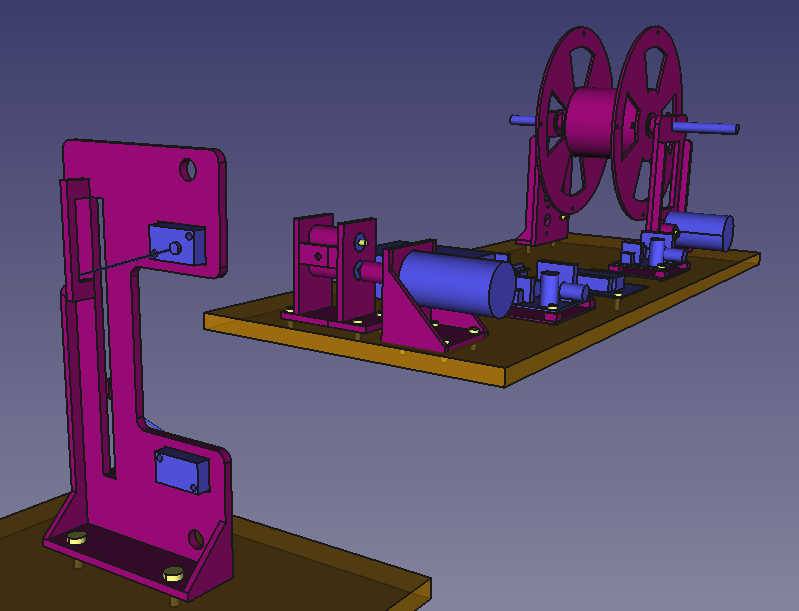
The filament winder wraps the extruded filament neatly onto a spool. This filament can then be used as virgin filament for running a 3D printer. The entire machine is controlled electronically, and Mr. Lyman has shown consistent filament production with a diameter consistent to +/- 0.05 mm.
The beauty of the filament maker lies in the ability to make low-cost printing filament locally. While a spool of filament costs about $10/lb, a person with a filament winder can produce their own filament for about 50 cents per pound – if they recycle their own plastic. The filament cost of 50 cents is the cost of electricity used to produce the 3D printing filament. OSE is interested in the filament maker in order to produce 3D printing filament locally – while cleaning up the environment from waste plastic. This workshop offers you an opportunity to see how a filament maker is built, and how it can be applied in your own recycling efforts. OSE’s goal is to develop a fully capable, open source, commercially-viable 3D printer filament maker.
3D Printer Construction Set
The 3D Printer Construction Set is a set of building blocks that allows you to build a CNC machine of any size – and also – if the parts are enlarged but the same design principles are used – to build other machines including a CNC Torch Table, a CNC Router, and a CNC Laser Cutter.
Just another 3D printer?
While there are many different 3D printers available – and they are becoming low cost and accessible – we felt that they are still complex enough to be beyond the reach of the average builder. To lower the barriers to 3D printing – and to multi-axis CNC machines in general – we decided to design the simplest possible 3D Printer in the world. We have gotten the unique parts count down to about 40 – which is about half that of an average printer.
We did not stop there. We decided to build a Construction Set – for any CNC machine. We are using magnetic connectors to attach the axes, tool head, end stops, power supply, the controller, and even the cable chain – making this system like a Lego set for rapid building. Our construction set approach allows us to stack, multiply, scale, piggyback, and otherwise reconfigure components for maximum flexibility. Our frame is heavy duty steel, so our system is more than a toy. We are designing a system intended to be scaled for industrial applications – consistent with our work on the Global Village Construction Set.
You can see more about the 3D printer in our last event announcement for the past August 12, 2017 workshop:
https://www.youtube.com/watch?v=KEUi1FXo-9k
Construction Set Design
To create a Construction Set – we designed a small set of identical parts that can be reconfigured. The core part is the open source OSE Universal Axis Module. The same axis module can be used in the x,y, and z directions – to create the x-y-z motion system:
Using this Universal Axis and taking advantage of the Construction Set approach, we have already built an open source CNC circuit mill. We reconfigured the axes compared to our 3D printer, and added a small router.
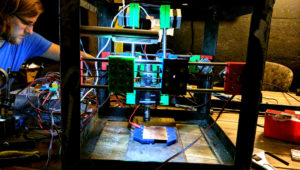
The metal guide rods can be larger or smaller – such as 1″ rods for heavier duty applications. The same axes as used above can be joined, lengthened, or stacked to build a much larger machine – such as this 4’x8’x1′ CNC Router:
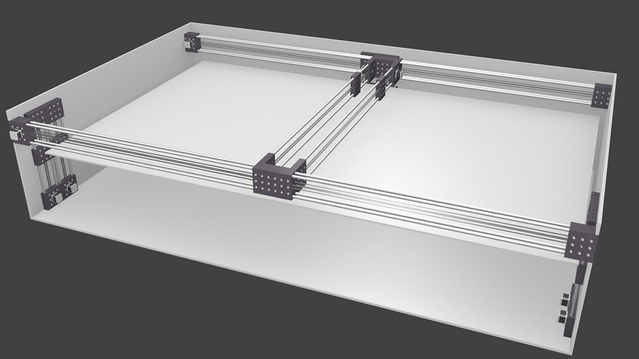
Note how the basic axis unit and its ability to connect to other axis units allows for a wide range of design variations, putting the ability to design CNC machines within the hands of ordinary people. Depending on the tool head that is used – the machine can have the functionality of the corresponding tool head – whether a 3D printer extruder, a router, a laser cutter, a cutting torch, or many others.

Parts can be stacked in multiples, as in this 9-headed production 3D Printer shown printing more parts for the axis unit:
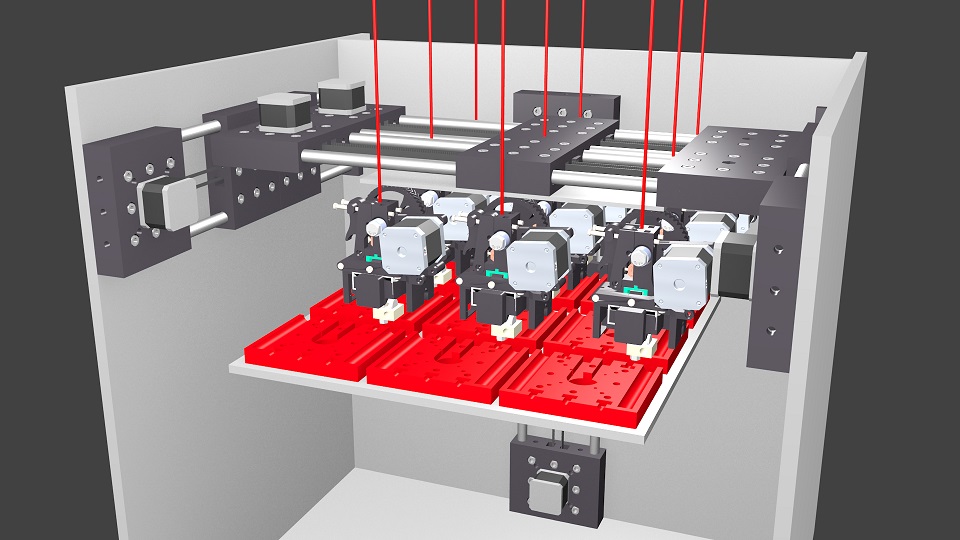
Lowest Unique Part Count in the World
The beauty lies in an absolute minimum number of parts that are used to build an infinite variety of CNC machines – depending on size, axis configuration, and tool heads. The unique part count for our 3D printer is only 40 – about half of comparable printers.
By making our machines simple and universal, we are aiming for the most widely replicated CNC build system in the world. To that end, we are inviting developers and entrepreneurs to join the OSE Development Team.
This workshop builds upon OSE’s Extreme Manufacturing approach of rapid building with multiple teams working in parallel on modular components. By simplifying the design and streamlining the build with digitally-fabricated, open source parts – people are now able to build a high quality 3D printer in record time at low cost.
We are also developing an open source enterprise model for how to run such workshops anywhere in the world. We are publishing our enterprise model openly, with all supporting information that helps people in a successful startup – without reinventing the wheel.
Workshop Options
In this workshop, you will build a 3D printer with an 8″x8″ or a larger 12″x12″ print area – a little bit more than double the print area of the smaller 8″x8″ version. We will use magnetic attachment for the 3D print head, power supply, and controller – while we will be attaching the axes now with bolts – as many people from the last workshop did not like the magnetic axis attachment because of the amount of effort it takes to do the magnets properly.
We have 12 spots open for this workshop. There are only 6 spots for the 12″x12″ print area version, and 6 spots for the 8″x8″ version. You may want to register early to assure that you can get the 12″ printer option.
Workshop Expectations
If you are expecting a consumer 3D printer – we suggest that you buy the open source Lulzbot 3D Printer. If you are looking for a printer that you can hack, modify, and get involved with on a deeper level – then this workshop is for you. We are expecting that you will get involved with your 3D printer – and use it as a learning platform for building more 3D printers or other products in the future. We don’t believe that a product is ever finished – and as such – we make changes and upgrades on a regular basis. In this workshop, we are adding a second Z axis to the printer for added stability, we are modifying the endstops, and adding external heated bed power so the machine goes up to temperature faster. We are working on design improvements that would allow us to build 24″x24″ print area machines – and larger. As such, we invite our participants to join our development team. During the workshop itself – expect some problem solving – as building a machine of high complexity typically has surprises.
Bring a Friend for Free
We also have a 2-for-1 offer – if you register to take a 3D printer home with you – you are welcome to bring one friend or family member with you for free.
Intended Audience
This workshop is intended for those people who don’t have the time to build a printer themselves – or who don’t think they have the skills to build one – but who are interested in an extremely streamlined and efficient process. The intended audience is also anyone who would consider running Extreme Manufacturing 3D printer workshops as part of their livelihood.
Participants will gain an appreciation for the productivity that happens when we break down the design into clear modules, such that multiple components can be assembled rapidly or in parallel based on clearly defined boundaries. This is an application of OSE’s radical modularity, just like we are applying to the heavy machines of the Global Village Construction Set:
We are guaranteeing that as a result of the 2 day immersion – the participants will walk away with a basic understanding of how to design and build their own 3D printer – including software setup. We estimate that the entire build should take 8 hours with one person. We do not require prior experience from our participants, as we teach the basics and work as a team.
We are offering a 2-for-1 offer if you would like to bring a friend or family member with you for free.
The end point of the day will be a successful, high quality print.
Team Workflow Expectations
In this workshop, we will build a total 12 3D printers – in One Day. In order to achieve this remarkable feat of efficiency – while maintaining an enjoyable experience – we expect all participants to work as a team. Using our modular build techniques, we will organize the event into teams based on the component modules of the 3D printer. These are the Frame, Axis, Extruder, Print Bed, and Power Supply. Then each builder will finish wiring the controller, up to orgnanizing all the wires in a 3D printed cable chain. Throughout the day, people are welcome to shift between the different teams, so that every participant will get a good overview of the entire build. When people shift between teams – we expect participants to teach each other.
Quality control is critical to our Extreme Manufacturing model. Because we establish production lines for each module – quality control will be greatly facilitated. Each module will have an example module prepared – and each team replicates that module exactly. Quality control thus simply involves visual inspection such that each batch of modules is identical. Key points are checked off from a list – and any errors can be caught early. Instead of waiting until final assembly to determine whether parts are correct – the visual inspection is spread throughout each batch of identical modules. This is a major win for quality control in distributed production.
There will be no stragglers going off into a corner to do their own build. The reason is not so much that a production line is faster than the one-off build. The main issue is that quality control in individual – as opposed to production line builds – is nearly impossible. Numerous mistakes would be made, and would lead to a very long build day or an unfinished printer.
You will get a feel for how such efficiency could lead to the feasibility of open source micro-factories that reinvent manufacturing – via collaborative, social production. Combined with automation of certain tasks (such as all the parts that have been 3D printed) – there are profound ramifications for ending the indignity of factory labor and replacing it with meaningful, closed loop production. OSE’s ultimate goal is that people evolve to freedom, as integrated humans, where artificial scarcity is no longer an issue.
Open Source Product Development Invitation
Workshop immersion involves concept and practice, and includes a crash course on Open Source Ecology. Participants become engaged in a part of OSE’s development process, where we produce open source blueprints for the infrastructures of civilization. Participants are introduced to basic principles of collaborative literacy – how the collaborative mindset can be used to solve wicked problems.
This workshop is intended for people interested in immersion, hands-on skills training and practical results. This immersion course may be especially useful to people who would like to make their livelihood by using open source enterprise. We are especially seeking participants with an entrepreneurial mindset to expand open source production into the mainstream. We are exploring the potential of open source economics by determining the limits of social production: can distributed, collaborative, community supported manufacturing (CSM) be an alternative to centralized factories? The overall workshop is designed for people interested in transitioning from consumer to producer. We welcome both complete novices and those with experience. The critical part is willingness to learn.
By joining this workshop, you have an opportunity to be part of a community interested in developing products collaboratively and open source, so that everyone can benefit. OSE’s goal is to promote right livelihood using open source – and part of that is starting enterprises – whether in 3D printing or in other productive areas. We are promoting the concept of distributive enterprise.
Have questions? Drop us an email: info at opensourceecology dot org
Instructors
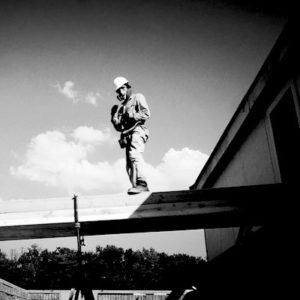
- Marcin Jakubowski (USA)- Marcin was trained as a fusion physicist. He left academia right after finishing his Ph.D. to start a farm – in Missouri – and founded Open Source Ecology. For the last 7 years, he has been working on the Global Village Construction Set – a set of enabling tools and machines for building regenerative infrastructures. Marcin is passionate about creating the Open Source Economy – a new operating system for Earth. See Marcin’s bio.
3D Printing
- Basic working principles of a 3D printer
- How to build a 3D printer
- How to calibrate a 3D printer
- How to run software to control a 3D printer
- How to find objects for printing and how to design them yourself in FreeCAD
- Design and build of a filament maker
- Different filament materials and applications
Collaborative Literacy
- Basic principles of Open Source Ecology
- The concept of Open Source Product Development (OSPD)
- The meaning of Distributive Enterprise
- Basic collaboration principles of open source projects
- How to engage in a collaborative documentation process
- The concept of module-based design
Distributive Enterprise
- Business model for Distributive Enterprise
- Extreme Manufacturing
- 100x Efficiency Improvement via Open Source Closed-Loop Production
- The meaning of Viral Replicability Criteria
Note: schedule is being refined and may change slightly. The full program goes from 8 AM to 6 PM each day. The Friday before the event is optional – and is extra preparation for the event for those who arrive early.
Friday Night (Optional):
- 7-9 PM:Introductio to FreeCAD, how to design parts in FreeCAD; How to find and modify 3D printing files; D3D Part Library. D3D Documentation. Control Software: Marlin, Cura, and Printer Profiles. Workshop orientation and etiquette. Part Inventory.
Day 1: 3D Printer
- 8 AM: OSE + Event Introduction
- Morning: Workshop Orientation and Beginning of Build.
- Lunch
- Afternoon: Afternoon Build Session. Control Software and Calibration for the 3D Printer. Electronics Build. First Prints.
- 6-9 PM: Review and Learning Discussion
Day 2: Filament Maker
- 8 AM: Introduction to the Filament Maker
- Morning: Beginning of Build.
- Lunch
- Afternoon: Afternoon Build Session. First production of filament.
- 6-8 PM: Review and Learning Discussion
Early Bird Registration: $699 for the 8″x8″ print area 3D printer; $899 for the 12″x12″ print area 3D printer. This includes admission to the second day of the workshop as a bonus.
Early Bird Admission ends on September 16, 2017 at 7 PM CST USA time. The registration is $799 and $999 after that.
Filament Maker Workshop: We also offer registration for only the Experimental Filament Maker portion of the workshop. The cost for this is $95 for the day.
Group Rate: Email us if you would like to bring a group.
True Fans of OSE: As supporting members of OSE, True Fans who have been subscribed for 6 or more months receive a 25% discount on all of our workshops. This discount is only for the tuition part part of the registration fee, but not the 3D printer materials cost. Email us for details. You can sign up as a True Fan now to become eligible for the True Fans discount on future workshops.
Sponsor another participant or Donate to OSE: We are a nonprofit organization with 501(c)3 status. You can make tax-deductible contributions to us. Sponsor $699 to fund attendance of someone who is on the waiting list for financial assistance by making a donation. We receive low-income assistance requests for all of our workshops.
Logistics: Email us if you would like to bring a group. Workshop fee does not include food, but snacks will be provided. We have a barbecue grill and a kitchen available at HabLab, so feel free to bring ingredients. You will be responsible for your accommodations, and wild camping is available on site. If you would like to stay in the HabLab, our shared room dormitory, you may also do that as well for $15 per night.
Payment Options: PayPal, Credit Card, Dwolla, Bitcoin, Check, Money Order, Wire Transfer, or Cash
Registration for the choices above is found on Eventbrite, but Eventbrite accepts only PayPal or Credit Card. If you would like to pay by other means you can select that option at Eventbrite, but then you have to submit your payment independently of Eventbrite. We accept Dwolla, Bitcoin, Check, Money Order, or Cash. Your registration is complete upon receipt of payment. If you pay with Dwolla – Dwolla charges lower transaction costs than PayPal. If you are paying by Dwolla, register at Eventbrite and select the Dwolla option, then pay independently via Dwolla (Dwolla is not currently integrated into Eventbrite). Use Open Source Ecology or ops@opensourceecology.org as the Dwolla recipient. Bitcoin is a decentralized payment system. You can pay via a bitcoin amount translated by the current bitcoin exchange rate on the day that you register. OSE’s Bitcoin Address is 166yC48RakrZdtsBj36vY9q29CpzknHbxY. If you are paying by check, please make checks payable to Open Source Ecology. Our mailing address is OSE, 909 SW Willow Rd, Maysville, MO 64469. For mailings, please write “3D Printer Construction Set Workshop” in the memo line on your check. For wire transfers, please email us at ops@opensourceecology.org for further directions.
Cancellation Policy
If you need to cancel for any reason, we will be happy to (a) transfer you credit towards another workshop in the future; (b) substitute the name on your ticket and have a friend take your place.
Registration on Eventbrite
Please use the the Eventbrite form below to pay with PayPal/credit card. Eventbrite charges a small fee.

Love the work you’re doing!
Do you know if and when your next 3-D Printing workshop will be for 2018? If so, please let me know. Regards, Jim
hello I missed the deadline shortly after this ended( the 3d printer workshop October 1, 2017) and have been beating my head against a wall for not knowing that this was happening. I am a big fan of the kind of work your trying to push and taking control of building and living beyond what is given to us is what I think is so amazing about your 3d printer setup. I am curious if you will have any work shops like this one in 2018? please let me know I would really be mad at my self if I missed a great opportunity again.
Hi,
Will you guys be offering anymore future 3D Printer Workshops? I am very interested in learning more about this.
Thanks,
Elena
More coming in 2018.